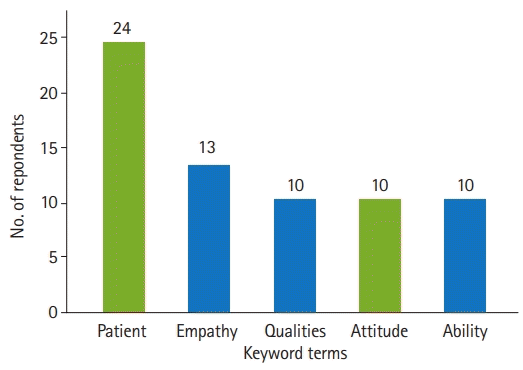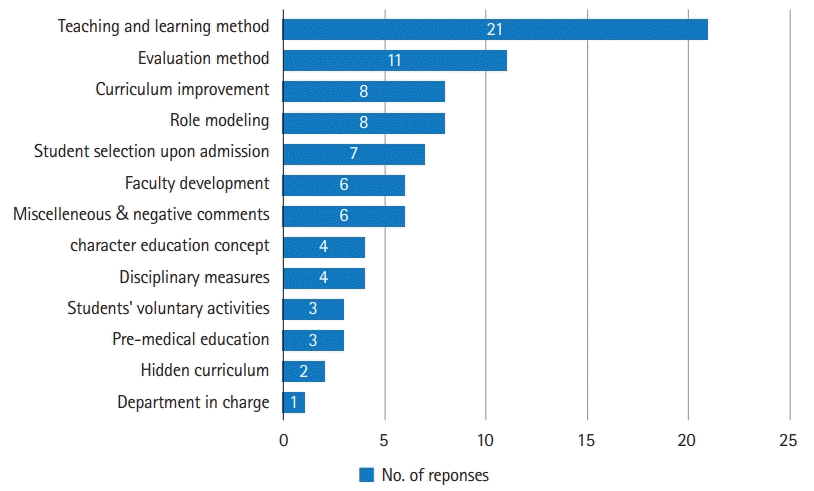Introduction
Background
Objectives
Methods
Ethics statement
Study design
Setting
Participants (subjects)
Table 1.
| Subjects | Survey rounda) | No. of responses |
|---|---|---|
| Medical education experts | ||
| Medical school professors | 1st | 34 |
| 2nd | 29 | |
| Subtotal | 63 | |
| Non-medical education experts | ||
| Private practice physicians | 1st | 11 |
| Medical students | 1st | 6 |
| Nursing school professors | 1st | 2 |
| Subtotal | 19 | |
| Total | 82 |
Data sources/measurement
Statistical methods
Results
Extracted keywords related to character
Table 3.
| Rank | Keyword terms (no. of times mentioned) |
No. of mentions by respondent groups |
Total no. of mentions | |
|---|---|---|---|---|
| Medical education experts (n=63) | Othersa) (n=19) | |||
| 1 | Patient/s (32), pain of the patient (2), patient’s pain (2), patient difficulties (1), patient care (1), life of patient (1) | 24 | 15 | 39 |
| 2 | Empathy (13), empathize (5), empathic (1), empathizing (1) | 13 | 3 | 16 |
| 3 | Qualities (8), basic qualities (1), internal quality (1), human quality (1) | 10 | 5 | 15 |
| Attitude (8), professional attitude(s) (2), basic attitude (1), conscientious attitude (1), positive attitude (1), unchanging attitude (1) | 10 | 2 | 13 | |
| Ability (11) | 10 | 1 | 11 | |
| 6 | Human being (5), humans (4), humane (1), human nature (1) | 9 | 3 | 12 |
| Ethics (3), medical ethics (3), professional ethics (2), sense of ethics (1), ethical judgment (1), basic ethical consciousness (1) | 9 | 2 | 11 | |
| Others (11), help others (1) | 9 | 2 | 11 | |
| 9 | Respect (8) | 8 | 0 | 8 |
| 10 | Responsibility (6), responsible (1) | 7 | 0 | 7 |
| Communicate (3), communication(s) (2), skill to communicate (1), communication ability (1) | 7 | 0 | 7 | |
| Cooperation (5), community cooperation (2), cooperate (1) | 7 | 1 | 8 | |
| Colleagues (6), co-worker(s) (2) | 7 | 1 | 8 | |
| 14 | Honesty (6), honest (1) | 6 | 1 | 7 |
| Consideration (6), considerate (3) | 6 | 3 | 9 | |
| Life (4), human life (2), worthwhile life (1), life or death (1), healthier social life (1), love of life (1) | 6 | 4 | 10 | |
| Understand/ing (14), comprehensive understanding (1) | 6 | 9 | 15 | |
| 18 | Caring (2), care (2), best possible care (1) | 5 | 0 | 5 |
| Caregiver/s (6) | 5 | 1 | 6 | |
| People (6), loves people (1) | 5 | 3 | 8 | |
| Morality (5), moral character (1), moral influence (1) | 5 | 3 | 8 | |
| 22 | Sympathy (3), emotionally sympathetic (1) | 4 | 0 | 4 |
| Family (4) | 4 | 0 | 4 | |
| Value/s (4), clear values (1) | 4 | 1 | 5 | |
| Society (4), member of society (1) | 4 | 2 | 6 | |
| 26 | Self-reflection (2), self-reflect (1) | 3 | 0 | 3 |
| Desirable (2), desirable thought (1) | 3 | 0 | 3 | |
| Competence (1), medical professional competence (1), practical competence (1) | 3 | 0 | 3 | |
| Characters (1), basic character (1), characteristics (1), innate character (1) | 3 | 1 | 3 | |
| Altruism (4) | 3 | 1 | 4 | |
| Professional (3), profession (1), professionally (1) | 3 | 2 | 5 | |
| Heart (7), warm heart (1) | 3 | 5 | 8 | |
| 33 | Role (2), given role (1) | 2 | 1 | 3 |
| Relationship/s (1), healthy relationship (1), mutually good relationship (1) | 2 | 1 | 3 | |
| Service spirit (2), serve (1), service mind (1), spirit of service (1) | 2 | 2 | 4 | |
| 36 | Compassion (2), compassionate (1) | 1 | 3 | 4 |
| Sincerity (2), sincere (2) | 1 | 3 | 4 | |
| Point of view (4) | 1 | 4 | 5 | |
| 37 | Treatment (2), applicable treatment (1) | 0 | 3 | 3 |
The operational definition of character for medical students
The basic qualities and ability to empathize with patients affected by illness based on respect for patients and others, to have basic ethical awareness and responsibility for human life, and to cooperate and communicate with colleagues.
Solutions to the issues of character education
“For character education, field education, including clinical practice, is a more effective method than lectures, but I think that the field of character education practice in Korean medical schools is not educational at all.”
“If flipped learning is actively introduced so that students can help each other in class and create results, that in itself would be very helpful for character education.”
“Reinforcing team-based activity and reflecting peer evaluation, and writing essays on a variety of topics.”
“It is necessary to organize the content and format of the medical humanities curriculum in such a way that experience is possible. It is necessary to have a program that exposes students to real situations rather than lectures. Programs should provide opportunities to experience empathy, consideration, and dedication, as well as a system to reflect on them. For example, after pre-medical years, a one-to-one relationship with an elderly patient can be established. In addition to regular visits, a program can be operated to participate in medical care together during hospital visits until graduation. Debriefing opportunities should be provided to reflect on the results.”
[Responses on the evaluation method]
“A portfolio including self-reflection for each item of personality element and feedback on it (multiple evaluations are required, and the evaluator must receive proper training before proceeding with the assessment).”
“Reinforcing team-based activity and reflecting peer evaluation, and writing essays on a variety of topics.”
[Responses on role modeling]
“It is necessary to change the character quality of the self-proclaimed medical education executives (those who are assigned in such positions). We need people with the humility to know that what they know is not everything and respect other fields of study. Doctors don’t know how ignorant they are. The crux of the matter is that they want to spend their whole lives with the triumph of their teenage years. You reap what you sow.”
“In the end, the appearance of senior doctors/professors who see and hear what happens in the clinical field determines the success or failure of character education as a whole.”
[Responses on curriculum development in general]
“Recently, unlike in the past, students’ character qualities show individual, selfish, and hypocritical behaviors, so it is urgent to develop a curriculum and professors specializing in character education.”
“If possible, we should apply interprofessional education to teaching/training not only within the medical school context/curriculum, but also with students in related fields such as nursing, clinical psychology, pharmacy, and social work. I am sure that this will be a good opportunity for dialogue between occupations, exploration, self-discovery, and understanding other occupations. It is hoped that this IPE model will be introduced and expanded in many medical schools in Korea.”
“It seems necessary to find a way to choose well when selecting incoming students. The 4–6 years of education after admission may help, but the basic tendencies also seem to be necessary.”
“Within the current system, I think the most specific alternative is to develop a method for selecting students with outstanding character at the time of admission.”
Discussion
Key results
Interpretation
“The character that a doctor requires is the basic attitude, values, and mindset that must be present to perform his or her duties. These include respect for human beings, empathy and consideration for patients, a sense of calling, honesty, ethics, and responsibility.”
Education that fosters the basic qualities and ability to empathize with patients affected by illness based on respect for patients and others, to have basic ethical awareness and responsibility for human life, and to cooperate and communicate with colleagues.




 PDF
PDF Citation
Citation Print
Print






 XML Download
XML Download